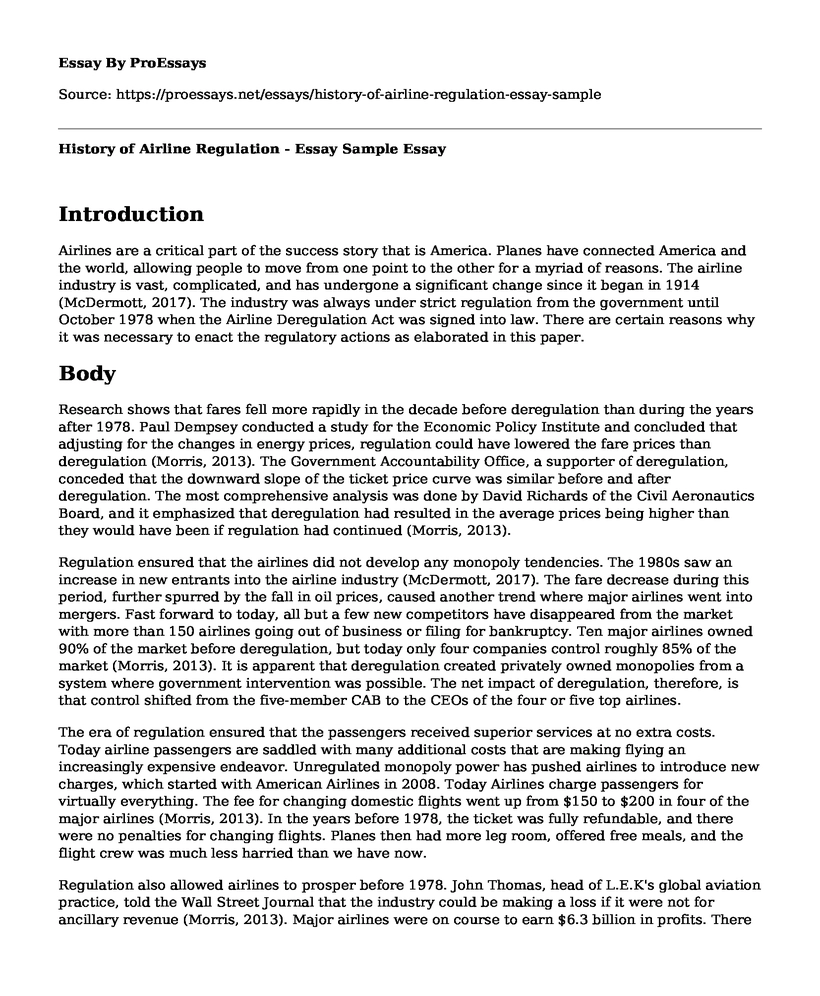Introduction
Airlines are a critical part of the success story that is America. Planes have connected America and the world, allowing people to move from one point to the other for a myriad of reasons. The airline industry is vast, complicated, and has undergone a significant change since it began in 1914 (McDermott, 2017). The industry was always under strict regulation from the government until October 1978 when the Airline Deregulation Act was signed into law. There are certain reasons why it was necessary to enact the regulatory actions as elaborated in this paper.
Body
Research shows that fares fell more rapidly in the decade before deregulation than during the years after 1978. Paul Dempsey conducted a study for the Economic Policy Institute and concluded that adjusting for the changes in energy prices, regulation could have lowered the fare prices than deregulation (Morris, 2013). The Government Accountability Office, a supporter of deregulation, conceded that the downward slope of the ticket price curve was similar before and after deregulation. The most comprehensive analysis was done by David Richards of the Civil Aeronautics Board, and it emphasized that deregulation had resulted in the average prices being higher than they would have been if regulation had continued (Morris, 2013).
Regulation ensured that the airlines did not develop any monopoly tendencies. The 1980s saw an increase in new entrants into the airline industry (McDermott, 2017). The fare decrease during this period, further spurred by the fall in oil prices, caused another trend where major airlines went into mergers. Fast forward to today, all but a few new competitors have disappeared from the market with more than 150 airlines going out of business or filing for bankruptcy. Ten major airlines owned 90% of the market before deregulation, but today only four companies control roughly 85% of the market (Morris, 2013). It is apparent that deregulation created privately owned monopolies from a system where government intervention was possible. The net impact of deregulation, therefore, is that control shifted from the five-member CAB to the CEOs of the four or five top airlines.
The era of regulation ensured that the passengers received superior services at no extra costs. Today airline passengers are saddled with many additional costs that are making flying an increasingly expensive endeavor. Unregulated monopoly power has pushed airlines to introduce new charges, which started with American Airlines in 2008. Today Airlines charge passengers for virtually everything. The fee for changing domestic flights went up from $150 to $200 in four of the major airlines (Morris, 2013). In the years before 1978, the ticket was fully refundable, and there were no penalties for changing flights. Planes then had more leg room, offered free meals, and the flight crew was much less harried than we have now.
Regulation also allowed airlines to prosper before 1978. John Thomas, head of L.E.K's global aviation practice, told the Wall Street Journal that the industry could be making a loss if it were not for ancillary revenue (Morris, 2013). Major airlines were on course to earn $6.3 billion in profits. There was $15 billion worth of revenue from services and items that were freely provided under regulation. Excluding this figure from the industry would mean that airlines would make a $9 billion loss today if they only relied on ticket sales like it was before deregulation (Morris, 2013).
Conclusion
Airline deregulation is one of the most effective reforms to have occurred in America. It allowed private entities to decide their routes and ticket prices which led to an increase in air travel. It is evident, however, that regulation was a necessary step by the government. It avoided a monopoly situation while ensuring stability in ticket pricing and service delivery. It kept the fares comparatively lower than today and ensured that the airlines still made profits.
References
McDermott, J. (2017). The History of Airline (De)Regulation in The United States. Retrieved from https://aeronauticsonline.com/the-history-of-airline-deregulation-in-the-united-states/
Morris, D. (2013). Airline Deregulation: A Triumph of Ideology Over Evidence. Retrieved from https://www.huffingtonpost.com/david-morris/airline-deregulation-ideology-over-evidence_b_4399150.html
Cite this page
History of Airline Regulation - Essay Sample. (2022, Jul 20). Retrieved from https://proessays.net/essays/history-of-airline-regulation-essay-sample
If you are the original author of this essay and no longer wish to have it published on the ProEssays website, please click below to request its removal:
- Paper Example on Independent, Dependent, and Intervening Variables
- Essay Example on Pop Culture: Shaping American Reality
- Essay Example on Latin America's Industrial Revolution: Nationalism, Unlawful Force, and Conflict
- Changing Categorization of Races: Impact of Science, Politics, and Public Attitudes
- Evaluating Non-Auditory Factors in Airport Noise Complaint Rates
- Essay on Intergovernmental Interactions Impacting Federal System Operations
- Paper Example on State Shouldn't Interfere in Consensual Relationships between Adults Over 21







